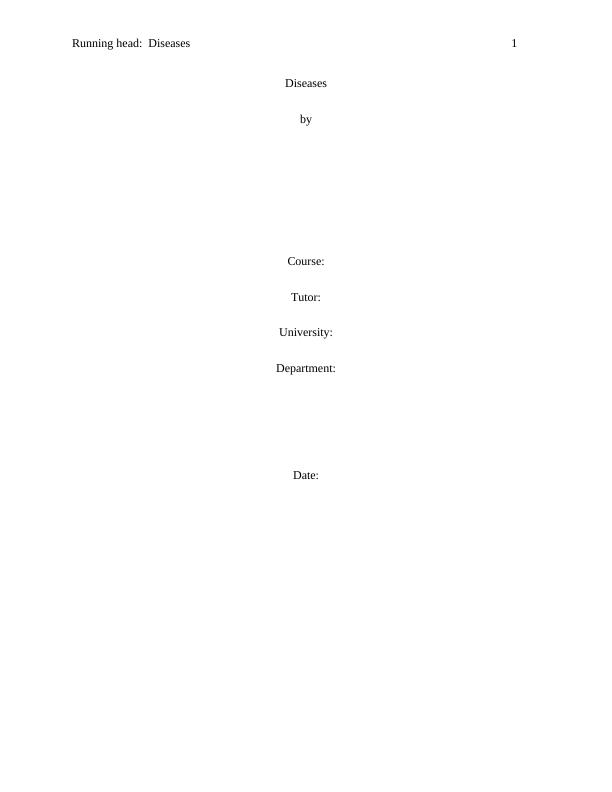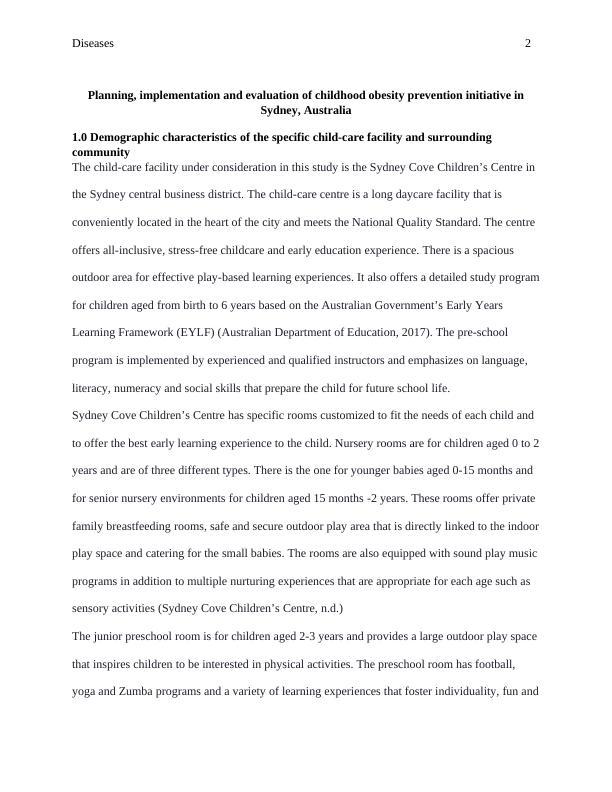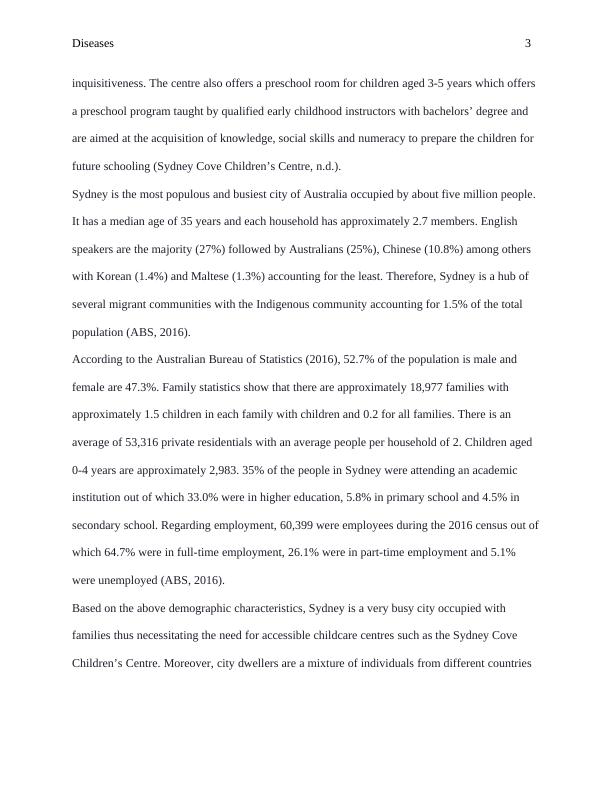Child Care Facility Under Consideration Case Study 2022
Added on 2022-10-02
18 Pages4951 Words34 Views
Running head: Diseases 1
Diseases
by
Course:
Tutor:
University:
Department:
Date:
Diseases
by
Course:
Tutor:
University:
Department:
Date:

Diseases 2
Planning, implementation and evaluation of childhood obesity prevention initiative in
Sydney, Australia
1.0 Demographic characteristics of the specific child-care facility and surrounding
community
The child-care facility under consideration in this study is the Sydney Cove Children’s Centre in
the Sydney central business district. The child-care centre is a long daycare facility that is
conveniently located in the heart of the city and meets the National Quality Standard. The centre
offers all-inclusive, stress-free childcare and early education experience. There is a spacious
outdoor area for effective play-based learning experiences. It also offers a detailed study program
for children aged from birth to 6 years based on the Australian Government’s Early Years
Learning Framework (EYLF) (Australian Department of Education, 2017). The pre-school
program is implemented by experienced and qualified instructors and emphasizes on language,
literacy, numeracy and social skills that prepare the child for future school life.
Sydney Cove Children’s Centre has specific rooms customized to fit the needs of each child and
to offer the best early learning experience to the child. Nursery rooms are for children aged 0 to 2
years and are of three different types. There is the one for younger babies aged 0-15 months and
for senior nursery environments for children aged 15 months -2 years. These rooms offer private
family breastfeeding rooms, safe and secure outdoor play area that is directly linked to the indoor
play space and catering for the small babies. The rooms are also equipped with sound play music
programs in addition to multiple nurturing experiences that are appropriate for each age such as
sensory activities (Sydney Cove Children’s Centre, n.d.)
The junior preschool room is for children aged 2-3 years and provides a large outdoor play space
that inspires children to be interested in physical activities. The preschool room has football,
yoga and Zumba programs and a variety of learning experiences that foster individuality, fun and
Planning, implementation and evaluation of childhood obesity prevention initiative in
Sydney, Australia
1.0 Demographic characteristics of the specific child-care facility and surrounding
community
The child-care facility under consideration in this study is the Sydney Cove Children’s Centre in
the Sydney central business district. The child-care centre is a long daycare facility that is
conveniently located in the heart of the city and meets the National Quality Standard. The centre
offers all-inclusive, stress-free childcare and early education experience. There is a spacious
outdoor area for effective play-based learning experiences. It also offers a detailed study program
for children aged from birth to 6 years based on the Australian Government’s Early Years
Learning Framework (EYLF) (Australian Department of Education, 2017). The pre-school
program is implemented by experienced and qualified instructors and emphasizes on language,
literacy, numeracy and social skills that prepare the child for future school life.
Sydney Cove Children’s Centre has specific rooms customized to fit the needs of each child and
to offer the best early learning experience to the child. Nursery rooms are for children aged 0 to 2
years and are of three different types. There is the one for younger babies aged 0-15 months and
for senior nursery environments for children aged 15 months -2 years. These rooms offer private
family breastfeeding rooms, safe and secure outdoor play area that is directly linked to the indoor
play space and catering for the small babies. The rooms are also equipped with sound play music
programs in addition to multiple nurturing experiences that are appropriate for each age such as
sensory activities (Sydney Cove Children’s Centre, n.d.)
The junior preschool room is for children aged 2-3 years and provides a large outdoor play space
that inspires children to be interested in physical activities. The preschool room has football,
yoga and Zumba programs and a variety of learning experiences that foster individuality, fun and

Diseases 3
inquisitiveness. The centre also offers a preschool room for children aged 3-5 years which offers
a preschool program taught by qualified early childhood instructors with bachelors’ degree and
are aimed at the acquisition of knowledge, social skills and numeracy to prepare the children for
future schooling (Sydney Cove Children’s Centre, n.d.).
Sydney is the most populous and busiest city of Australia occupied by about five million people.
It has a median age of 35 years and each household has approximately 2.7 members. English
speakers are the majority (27%) followed by Australians (25%), Chinese (10.8%) among others
with Korean (1.4%) and Maltese (1.3%) accounting for the least. Therefore, Sydney is a hub of
several migrant communities with the Indigenous community accounting for 1.5% of the total
population (ABS, 2016).
According to the Australian Bureau of Statistics (2016), 52.7% of the population is male and
female are 47.3%. Family statistics show that there are approximately 18,977 families with
approximately 1.5 children in each family with children and 0.2 for all families. There is an
average of 53,316 private residentials with an average people per household of 2. Children aged
0-4 years are approximately 2,983. 35% of the people in Sydney were attending an academic
institution out of which 33.0% were in higher education, 5.8% in primary school and 4.5% in
secondary school. Regarding employment, 60,399 were employees during the 2016 census out of
which 64.7% were in full-time employment, 26.1% were in part-time employment and 5.1%
were unemployed (ABS, 2016).
Based on the above demographic characteristics, Sydney is a very busy city occupied with
families thus necessitating the need for accessible childcare centres such as the Sydney Cove
Children’s Centre. Moreover, city dwellers are a mixture of individuals from different countries
inquisitiveness. The centre also offers a preschool room for children aged 3-5 years which offers
a preschool program taught by qualified early childhood instructors with bachelors’ degree and
are aimed at the acquisition of knowledge, social skills and numeracy to prepare the children for
future schooling (Sydney Cove Children’s Centre, n.d.).
Sydney is the most populous and busiest city of Australia occupied by about five million people.
It has a median age of 35 years and each household has approximately 2.7 members. English
speakers are the majority (27%) followed by Australians (25%), Chinese (10.8%) among others
with Korean (1.4%) and Maltese (1.3%) accounting for the least. Therefore, Sydney is a hub of
several migrant communities with the Indigenous community accounting for 1.5% of the total
population (ABS, 2016).
According to the Australian Bureau of Statistics (2016), 52.7% of the population is male and
female are 47.3%. Family statistics show that there are approximately 18,977 families with
approximately 1.5 children in each family with children and 0.2 for all families. There is an
average of 53,316 private residentials with an average people per household of 2. Children aged
0-4 years are approximately 2,983. 35% of the people in Sydney were attending an academic
institution out of which 33.0% were in higher education, 5.8% in primary school and 4.5% in
secondary school. Regarding employment, 60,399 were employees during the 2016 census out of
which 64.7% were in full-time employment, 26.1% were in part-time employment and 5.1%
were unemployed (ABS, 2016).
Based on the above demographic characteristics, Sydney is a very busy city occupied with
families thus necessitating the need for accessible childcare centres such as the Sydney Cove
Children’s Centre. Moreover, city dwellers are a mixture of individuals from different countries

Diseases 4
and cultures. This is important because it determines the language and curriculum to be used in
the childcare centres that doesn’t segregate those from foreign cultures.
1.2 Etiology and epidemiology of overweight and obesity in the target group
1.2.1 Epidemiology
Over 124 million children and teenagers aged 5-19 years worldwide are obese with the incidence
rates (over 20%) being the highest the Caribbean, North Africa, and the Middle East. USA has
the highest prevalence of childhood obesity among the 34 country members of the Organization
for Economic Co-operation and Development with Australia taking the 5th position (Abarca-
Gómez et al., 2017). The incidence of obesity among primary school kids in Australia in 2015
was 22.9%, with obesity accounting for 7.1% (Hardy, King, Espinel, Cosgrove, & Bauman,
2016). The frequency of acute obesity rose in the same age category (Garnett, Baur, Jones, &
Hardy, 2016). The continuous widening gap of socioeconomic imbalances increases the
prevalence rates in children from lower socioeconomic status families (Hardy et al., 2016).
The pervasiveness of obesity and overweight among Indigenous Australian children is much
higher than non-Indigenous children. Research has indicated that Indigenous children residing in
rural parts have minimal incidences of obesity and overweight compared with their counterparts
in the city (Dyer et al., 2016). The incidence of obesity and overweight varies depending on the
race, ethnicity and socioeconomic factors. Childhood obesity is on the rise among different races
in the US (Maahs et al., 2014). It is also more common in populations of low socioeconomic
status. Childhood obesity and overweight is significantly determined by hereditary factors.
Obesity and overweight in a single parent predispose the child to obesity three times and up to
fifteen times if both parents are obese (Jiang, Yang, Guo, & Sun, 2013).
An overwhelming increase in childhood obesity has been observed in school-aged children and
early teenagers aged 6-11 years and 12-19 years respectively between 2009 and 2010 (Ogden,
and cultures. This is important because it determines the language and curriculum to be used in
the childcare centres that doesn’t segregate those from foreign cultures.
1.2 Etiology and epidemiology of overweight and obesity in the target group
1.2.1 Epidemiology
Over 124 million children and teenagers aged 5-19 years worldwide are obese with the incidence
rates (over 20%) being the highest the Caribbean, North Africa, and the Middle East. USA has
the highest prevalence of childhood obesity among the 34 country members of the Organization
for Economic Co-operation and Development with Australia taking the 5th position (Abarca-
Gómez et al., 2017). The incidence of obesity among primary school kids in Australia in 2015
was 22.9%, with obesity accounting for 7.1% (Hardy, King, Espinel, Cosgrove, & Bauman,
2016). The frequency of acute obesity rose in the same age category (Garnett, Baur, Jones, &
Hardy, 2016). The continuous widening gap of socioeconomic imbalances increases the
prevalence rates in children from lower socioeconomic status families (Hardy et al., 2016).
The pervasiveness of obesity and overweight among Indigenous Australian children is much
higher than non-Indigenous children. Research has indicated that Indigenous children residing in
rural parts have minimal incidences of obesity and overweight compared with their counterparts
in the city (Dyer et al., 2016). The incidence of obesity and overweight varies depending on the
race, ethnicity and socioeconomic factors. Childhood obesity is on the rise among different races
in the US (Maahs et al., 2014). It is also more common in populations of low socioeconomic
status. Childhood obesity and overweight is significantly determined by hereditary factors.
Obesity and overweight in a single parent predispose the child to obesity three times and up to
fifteen times if both parents are obese (Jiang, Yang, Guo, & Sun, 2013).
An overwhelming increase in childhood obesity has been observed in school-aged children and
early teenagers aged 6-11 years and 12-19 years respectively between 2009 and 2010 (Ogden,

End of preview
Want to access all the pages? Upload your documents or become a member.
Related Documents
Diploma In Children's Services - Early Years Learning Framework for Australialg...
|9
|2286
|12
Report on Business Plan for Managing Preschool & Nurserylg...
|26
|8968
|487
Essay on Schools as Organisationlg...
|31
|10447
|72
Community Agency Researchlg...
|5
|981
|399
Diploma of Early Childhood Education and Care Module National Quality Framework Qualification(s) CHC50113 Diploma of Early Childhood Education and Carelg...
|13
|3094
|113
Behavior Management for Young Children - Deskliblg...
|14
|3807
|392
